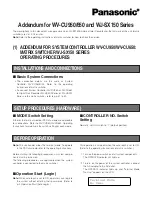
96
4.4 Link Aggregation
Port Aggregation optimizes port usage by linking a group of ports together to form a single Link Aggregated Groups
(LAGs). Port Aggregation multiplies the bandwidth between the devices, increases port flexibility, and provides link
redundancy.
Each LAG is composed of ports of the same speed, set to full-duplex operations. Ports in a LAG, can be of different
media types (UTP/Fiber, or different fiber types), provided they operate at the same speed.
Aggregated Links can be assigned manually (
Port Trunk
) or automatically by enabling Link Aggregation Control
Protocol (
LACP
) on the relevant links.
Aggregated Links are treated by the system as a single logical port. Specifically, the Aggregated Link has similar port
attributes to a non-aggregated port, including auto-negotiation, speed, Duplex setting, etc.
The device supports the following Aggregation links :
Static LAGs
(
Port Trunk
) – Force aggregared selected ports to be a trunk group.
Link Aggregation Control Protocol
(
LACP
) LAGs - LACP LAG negotiate Aggregated Port links with
other LACP ports located on a different device. If the other device ports are also LACP ports, the devices
establish a LAG between them.
Содержание NS3500-28T-4S
Страница 1: ...NS3500 28T 4S User Manual P N 1072835 REV 00 01 ISS 14JUL14 ...
Страница 41: ...41 3 Press the Apply button to save running configuration to startup configuration ...
Страница 145: ...145 Figure 4 6 2 Before Applying the STA Rules In this example only the default STP values are used ...
Страница 166: ...166 Figure 4 7 4 Multicast Flooding ...
Страница 255: ...255 The page includes the following fields Object Description DHCP Snooping Display the current DHCP snooping status ...
Страница 260: ...260 Buttons Click to clear the statistics Click to refresh the statistics ...
Страница 282: ...282 Figure 4 9 66 Global DoS Setting Page Screenshot ...
Страница 296: ...296 ...
Страница 303: ...303 ...
















































